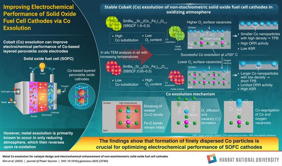Home > Press > Hanbat National University researchers present new technique to boost solid oxide fuel cell performance: Researchers demonstrate cobalt exsolution in solid oxide fuel cell cathodes in oxidizing atmospheres, presenting a new direction for fuel cell research
 |
| Cobalt exsolution occurs in layered perovskite oxides in oxidizing atmospheres, above 700°C, and is governed by the formation of oxygen vacancies in the materials
Credit Hanbat National University |
Abstract:
Fuel cells are an efficient, clean alternative to traditional fossil-fuel-based energy systems. Solid oxide fuel cells (SOFCs) are especially attractive due to their ability to use multiple fuels, high efficiency and reversibility. Cobalt (Co)-doped rare-earth layered perovskite oxides are attractive cathode materials for low- and medium-temperature SOFCs. They offer excellent electrochemical performance, owing to their high oxygen content and flexible control of oxygen transport.
Hanbat National University researchers present new technique to boost solid oxide fuel cell performance: Researchers demonstrate cobalt exsolution in solid oxide fuel cell cathodes in oxidizing atmospheres, presenting a new direction for fuel cell research
Daejeon, South Korea | Posted on October 3rd, 2025
Yet, electrodes made from these materials demonstrate low long-term stability. Key strategies to address this issue include the substitution of some Co with Iron (Fe) and growing Co nanoparticles on the electrode surface through a process called metal exsolution. However, exsolution has only been demonstrated under high temperature-reducing atmospheres. Under the actual oxidizing operating environment of SOFC cathodes, this process is reversed.
A research team led by Professor Junghyun Kim from the Department of Advanced Materials Engineering at Hanbat National University, Republic of Korea, has now challenged this view. We have presented the first experimental evidence of Co exsolution occurring in a high-temperature oxidizing atmosphere, challenging the conventional paradigm, explains Prof. Kim. Their study was made available online on May 21, 2025, and published in Volume 648 of the Journal of Power Sources on August 30, 2025.
The researchers first studied the electrochemical properties and oxygen (O) content of two layered perovskite structures: SmBa0.45Sr0.5(Co1-xFex)1.9O5+d (SBSCF 1.9) and SmBa0.5Sr0.48(Co1-xFex)2.05O5+d (SBSCF 2.05). Two specific samples of these structures: one with 30% Fe substitution in SBSCF 1.9 (SBSCF 1.9-0.3) and one with 50% Fe substitution in SBSCF 2.05 (SBSCF 2.05-0.5) showed the highest electrochemical performance and were chosen for further study. When exposed to oxidizing atmospheres at high temperatures, both samples exhibited Co exsolution above 700 °C. The number of particles increased with increasing temperatures, reaching a maximum at 900° C.
The researchers explained that under oxidising conditions and high temperature environments, the weaker Co-O bonds are broken, while the Fe-O bonds remain stable. These dissociated oxygen atoms diffuse to the surface, forming oxygen vacancies in the material. These vacancies and Co, then segregate together towards the surface, leading to Co-exsolution. As temperatures increase, more Co exsolution particles appear.
Interestingly, SBSCF 1.9-0.3 formed smaller, but more exsolved Co particles than SBSCF 2.05-0.5. This resulted in a lower area specific resistance (ASR) and higher oxygen reduction reaction (ORR) activity. This was linked to its higher surface oxygen vacancy concentration, originating from its lower Fe content. It also had higher Co-content.
Our results show that formation of finely dispersed exsolved Co particles is crucial for optimizing the electrochemical performance of SOFC cathodes, says Prof. Kim. Beyond SOFCs, these findings can also benefit oxygen separation membranes and environmental catalytic systems for clean-air technologies, and upcoming protonic ceramic fuel cells.
This study presents a new direction for fuel cell research, leading to more efficient and high-performance designs.
####
About Hanbat National University
Established in 1927, Hanbat National University (HBNU) is a university in Daejeon, South Korea. As a leading national university in the region, HBNU strives to take the lead in solving problems in the local community and solidifying its cooperation with industries. The universitys vision is to become an Innovation Platform University integrating local community, industry, academia, and research. With its focus on practical education and regional impact, HBNU continually advances technological solutions grounded in creative thinking and real-world relevance.
For more information, please click here
Contacts:
Chaewon An
Hanbat National University
Office: 82-42-828-8461
Copyright © Hanbat National University
If you have a comment, please Contact us.
Issuers of news releases, not 7th Wave, Inc. or Nanotechnology Now, are solely responsible for the accuracy of the content.
News and information
![]()
Researchers develop molecular qubits that communicate at telecom frequencies October 3rd, 2025
![]()
Next-generation quantum communication October 3rd, 2025
![]()
“Nanoreactor” cage uses visible light for catalytic and ultra-selective cross-cycloadditions October 3rd, 2025
Perovskites
![]()
KAIST researchers introduce new and improved, next-generation perovskite solar cell November 8th, 2024
![]()
Efficient and stable hybrid perovskite-organic light-emitting diodes with external quantum efficiency exceeding 40 per cent July 5th, 2024
![]()
Chemical reactions can scramble quantum information as well as black holes April 5th, 2024
Possible Futures
![]()
Spinel-type sulfide semiconductors to operate the next-generation LEDs and solar cells For solar-cell absorbers and green-LED source October 3rd, 2025
Announcements
![]()
Rice membrane extracts lithium from brines with greater speed, less waste October 3rd, 2025
![]()
Researchers develop molecular qubits that communicate at telecom frequencies October 3rd, 2025
![]()
Next-generation quantum communication October 3rd, 2025
![]()
“Nanoreactor” cage uses visible light for catalytic and ultra-selective cross-cycloadditions October 3rd, 2025
Interviews/Book Reviews/Essays/Reports/Podcasts/Journals/White papers/Posters
![]()
Spinel-type sulfide semiconductors to operate the next-generation LEDs and solar cells For solar-cell absorbers and green-LED source October 3rd, 2025
![]()
Rice membrane extracts lithium from brines with greater speed, less waste October 3rd, 2025
![]()
Researchers develop molecular qubits that communicate at telecom frequencies October 3rd, 2025
Energy
![]()
Sensors innovations for smart lithium-based batteries: advancements, opportunities, and potential challenges August 8th, 2025
![]()
Simple algorithm paired with standard imaging tool could predict failure in lithium metal batteries August 8th, 2025
![]()
KAIST researchers introduce new and improved, next-generation perovskite solar cell November 8th, 2024
Automotive/Transportation
![]()
Sensors innovations for smart lithium-based batteries: advancements, opportunities, and potential challenges August 8th, 2025
![]()
Simple algorithm paired with standard imaging tool could predict failure in lithium metal batteries August 8th, 2025
Fuel Cells
![]()
Deciphering local microstrain-induced optimization of asymmetric Fe single atomic sites for efficient oxygen reduction August 8th, 2025
![]()
Current and Future Developments in Nanomaterials and Carbon Nanotubes: Applications of Nanomaterials in Energy Storage and Electronics October 28th, 2022










